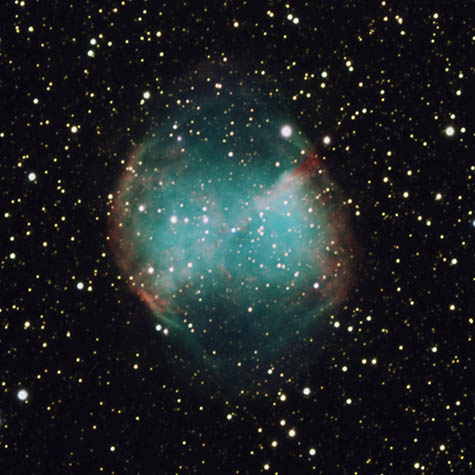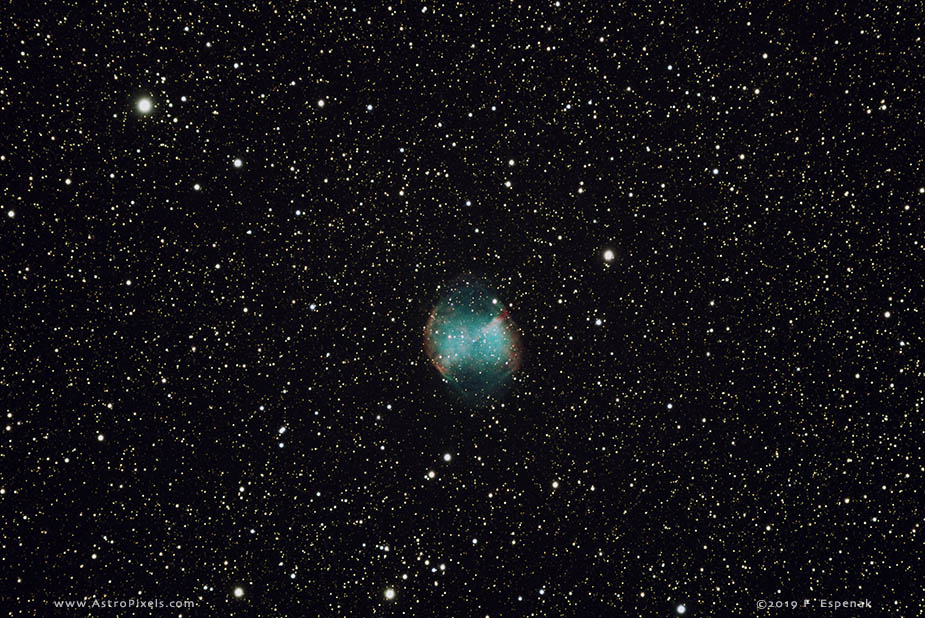
M27 - Dumbbell Nebula
Messier 27 or M27 (also designated NGC 6853) is a planetary nebula in the constellation Vulpecula. It has an apparent visual magnitude of 7.4 and its angular diameter is 8.0x5.7 arc-minutes. M27 lies at an estimated distance of 1250 light years. The Equinox 2000 coordinates are RA= 19h 59.6m, Dec= +22° 43´ which makes M27 best seen during the summer. The Messier Summer Star Chart shows the position of all Messier objects visible during that season. As one of the more famous objects in the Messier Catalog, it is commonly known as the Dumbbell Nebula.
The image above shows the uncropped view of M27 through the Astro-Physics 130EDF APO Refractor (130mm, f/6, fl=780mm). A cropped 2.5x enlargement of this image appears to the right.
M27 was discovered by Messier in 1764.It is one of only four planetary nebulae in the Messier Catalog (M27, M57, M76, and M97).John Hershel compared it to a "double-headed shot" and it later became known as the Dumbbell Nebula. The central star of M27 is an extremely hot white dwarf of about 85,000 K.According to Stoyan et al. (2010), the distance of M27 is 1150 light years and its diameter is 3.0 light years. Its estimated age is 9000 years but this value is uncertain.
Planetary nebulae are formed towards the end of life of an intermediate mass star that has thrown off its outer atmosphere (the nebula) exposing it to a very hot and luminous core. The ultraviolet light from the core energizes the shell of gas causing the nebula to glow. The period when a planetary nebula is visible around its core star is relatively short lived - estimated to be about only 10,000 years. For more on planetary nebulae see: Wikipedia.
For additional information on M27, see the Messier Catalog as well as specific entries for M27 in Wikipedia and SEDS.
Messier's Description of M27
July 12, 1764
`Nebula without star, discovered in Vulpecula, between the two forepaws, and very near the star 14 of that constellation, of 5th magnitude according to Flamsteed; one can see it well with an simple refractor of 3.5 feet; it appears of oval shape, and it contains no star. M. Messier has reported its position on the chart of the Comet of 1779, which was engraved for the volume of the Academy of the same year. Reviewed on January 31, 1781.' (diam. 4')
Technical Details
- Object: M27
- Other Names: NGC 6853, Dumbbell Nebula
- Object Type: planetary nebula
- Object Data: Apparent Magnitude = 7.4, Angular Size = 8.0x5.7 arc-minutes
- Object Position (Equinox 2000): RA= 19h 59.6m, Dec= +22° 43´, Constellation = Vulpecula
- Date: 2019 Sep 26
- Location: Bifrost Astronomical Observatory, Portal, AZ
- Telescope: Astro-Physics 130EDF APO Refractor (130mm, f/6, fl=780mm)
- Mount: Astro-Physics 1200GTO
- Camera: ZWO ASI183MC Pro
- Field of View: 58.2' x 38.8' at 0.63 arc-sec/pixel
- Exposure: 48 x 300 sec (= 4 hrs), f/6, Unit Gain, Temp.=-15° C
- File Name: M27-2019Sep26-1a.jpg
- Processing (Deep Sky Stacker): using Lights, Darks and Flats
- Processing (Photoshop CC): Curves, Levels, Layer Masks, Vibrance, Noise Reduction
- Original Image Size: 5496 × 3672 pixels (20.2 MP); 18.3" x 12.3" @ 300 dpi
- Rights: Copyright 2019 by Fred Espenak. All Rights Reserved. See: Image Licensing.
